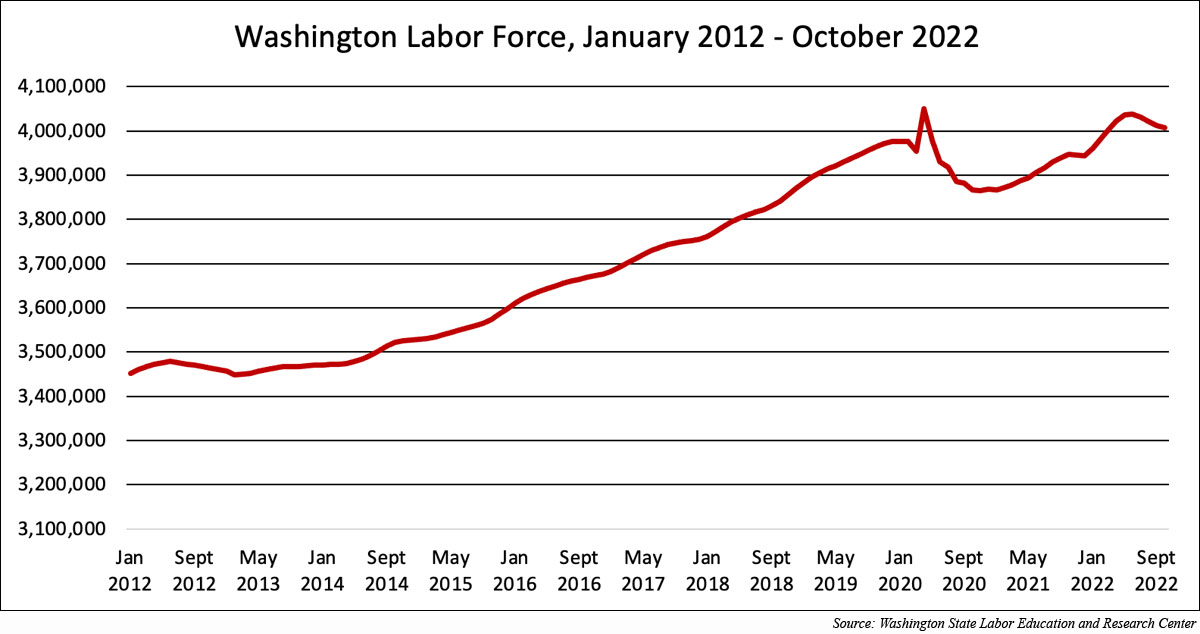LOCAL
New workforce analysis shows state’s uneven pandemic recovery
Labor Center report finds pandemic exacerbated existing employment inequalities in Washington
 SEATTLE (April 20, 2023) — Since March 2020, the Washington State Labor Education and Research Center has documented and analyzed the economic impact of the COVID-19 pandemic on Washington’s working families. Although the state of Washington formally ended the COVID state of emergency on Oct. 31, 2022, the economic costs to workers and our community will be long lasting. While overall employment has returned to pre-pandemic levels, and the unemployment rate has returned to historic lows, the pandemic is not over for many communities.
SEATTLE (April 20, 2023) — Since March 2020, the Washington State Labor Education and Research Center has documented and analyzed the economic impact of the COVID-19 pandemic on Washington’s working families. Although the state of Washington formally ended the COVID state of emergency on Oct. 31, 2022, the economic costs to workers and our community will be long lasting. While overall employment has returned to pre-pandemic levels, and the unemployment rate has returned to historic lows, the pandemic is not over for many communities.
An analysis of Summer 2022 employment data — as reported in the policy brief “Continued and Heightened Inequality Among Washington’s Post-Pandemic Workforce” by the Labor Center’s Muhammad Javid and David West, and Michael Mulcahy of Working Title Research — indicates that the pandemic built upon and exacerbated existing inequalities within the workforce. Specifically, the differentials in workforce participation and in unemployment rates between workers of different races, genders, ethnicities, and parental statuses have widened since before the pandemic.
Among the Labor Center’s findings:
● Mothers of small children and immigrant women continue to remain on the sidelines of our economy — This is likely due to the ongoing family care needs that disproportionately affect women, as examined in a Labor Center March 2021 policy brief. With the COVID-19 pandemic placing elders at higher risk and children often staying at home for school due to distance learning or COVID exposure and quarantine procedures, many women have had to prioritize family responsibility over return to work.
● Multiracial workers are disproportionately more likely to be unemployed — Among high school graduates, the likelihood for unemployment is the highest for multiracial workers at 8.4%. This is about a 3-point increase from the pre-pandemic level of 5.2%. Among holders of a 4-year college degree or higher, multiracial workers also see an increase in the likelihood of being unemployed, from 3.4% in 2019 to 4.7% in summer 2022.
● Black workers are also disproportionately more likely to be unemployed — Black high school graduates experienced an unemployment likelihood of 5.2%, well above the state average. This is a one-point increase from the pre-pandemic level of 4.2% for these workers. Among those with a high school diploma, Black and multiracial workers were the only groups to experience an increase in likelihood of unemployment by the Summer 2022, compared to before the pandemic.
“To attract workers back into the workforce, businesses and policymakers must use an equitable recovery approach that considers the pandemic’s impacts on all of Washington’s workers, addressing the many ways the pandemic has heightened existing inequities,” the Labor Center brief concludes. “We need further qualitative research to identify the precise barriers to reemployment faced by our communities with a focus on the experiences of Black men, multiracial workers, immigrant women, and mothers of young children. They comprise communities of workers that have been disproportionately impacted by the pandemic. Only with this detailed information, and policies which specifically target each barrier identified, can we move toward an equitable recovery for Washington workers, and a robust workforce for frustrated employers.”
Read the entire study here. (Also available in PDF format.)
PREVIOUSLY at The Stand:
Precarious essential workers hit hardest by pandemic: report (March 23, 2021)






